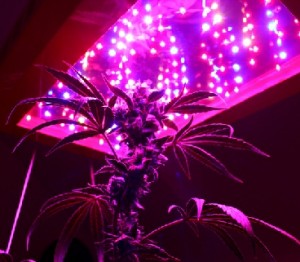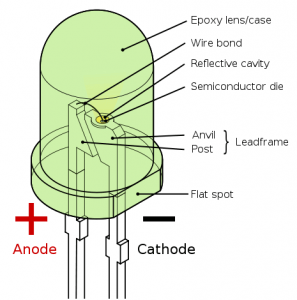
LED lights produce light by passing a current through a semiconductor. In LED lights no filament can burn out and this means that LEDs can have an extremely long lifetime, many LED lights on the market are rated for 50,000 – 60,000 hours.
Many LED systems have either the ‘blue’ spectrum, ‘red’ spectrum, or both depending on which system you purchase. There are multiple absorption peaks for chlorophyll and carotenoids so LED lights may use one or more LED colors overlapping these peaks.
The wattage of LED lights ranges from 12 watts to 400 watts in power usage while producing a ‘200 – 1,000 watt HID equivalent’ lighting for plants. Early LED growing lights used hundreds of fractional-watt LEDs and were often not bright enough or efficient enough to be effective replacements for HID lights.
Newer advanced LED grow lights may use high-brightness multiple-watt LED with growing results similar to HID lights. Grow light LEDs are increasing in power consumption resulting in increased effectiveness of the technology.
LED lights used in past designs were 1-watt in power, yet now 3-watt and even 5-watt LEDs are commonly used in LED grow lights. LED grow lights are now being produced which exceed 600 watts.
LED Lighting Advancements

Recent advancements in LED lights allow the production of bright and long-lasting grow lights relatively inexpensive that emit only the wavelengths of light corresponding to the absorption peaks of a plant’s typical photochemical processes.
Compared to other types of growing LED lights are attractive to indoor growers since they consume much less electrical power, don’t require ballasts, and produce considerably less heat. This allows LEDs to be placed closer to the plant canopy than other lighting systems.
Also, plants transpire less as a result of the heat reduction, and thus the time between watering cycles is longer. In traditional HID lighting, up to 95% of the energy is wasted by the creation and radiation of heat.
Whereas LED lights run relatively cool. With LED it is possible to place the light sources very close to the plants, usually around 12 – 18 inches or sometimes closer to prevent the plants from stretching and increasing the amount of light that is delivered to the plant.
The heat generated in a traditional grow room requires the grower to waste time, space, and energy trying to keep it cool. With HID lighting massive heat is generated from the growing operation and it is easier to be discovered by the authorities.
So with a good LED grow light system you can remove the cost, hassle, and noise associated with ventilation systems. Recommendations for optimal LED designs vary widely.
According to one source, to maximize plant growth and health using available and affordable LEDs, U.S. Patent #6921182 from July 2005 claims that “the proportion of twelve red 660 nm (nanometers) LEDs, plus six orange 612 nm LED’s and one blue 470 nm LED was optimal” such that the ratio of blue light to red and orange light is 6 – 8%.
It is also often published that for vegetative growth blue LED lights are preferred so the lighting has a wavelength somewhere in the mid-400 nm. For growing fruits or flowers, a greater proportion of deep-red LEDs is considered preferable with light very near 660 nm, but the exact number of this wavelength is much more critical than for the blue LED.
Though LED lights are new on the market, these lighting systems are gaining in popularity since more growers want to save money on lighting and cooling cost so people are making the switch to these new lighting systems. Though it should be noted, significant evidence of their productivity is yet to be found.
Let us know what you think.




Responses